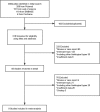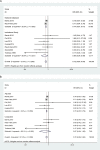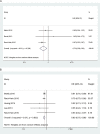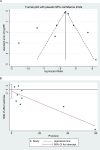Comparison of Survival Benefits of Combined Chemotherapy and Radiotherapy Versus Chemotherapy Alone for Uterine Serous Carcinoma: A Meta-analysis
- PMID: 28005619
- PMCID: PMC5181126
- DOI: 10.1097/IGC.0000000000000856
Comparison of Survival Benefits of Combined Chemotherapy and Radiotherapy Versus Chemotherapy Alone for Uterine Serous Carcinoma: A Meta-analysis
Abstract
Objective: To date, there is no convincing evidence comparing the impact of combined chemotherapy and radiotherapy with chemotherapy alone in postoperative uterine serous carcinoma (USC), which remains an unclear issue. We conducted a meta-analysis assessing the impact of combined chemotherapy and radiotherapy compared to chemotherapy alone on overall survival in postoperative USC.
Methods: A comprehensive search was performed in the databases of EMBASE, PubMed, Web of Science, and Cochrane Library from inception to March 2016. Studies comparing survival among patients who underwent combined chemotherapy and radiotherapy or chemotherapy alone after surgery for USC were included. Quality assessments were carried out by the Newcastle-Ottawa Scale. Hazard ratio (HR) for overall survival was extracted, and a random-effects model was used for pooled analysis. Publication bias was assessed using both funnel plot and the Egger regression test. Statistical analyses were performed using Stata version 13.0 software.
Result: Nine retrospective studies with relatively high quality containing 9354 patients were included for the final meta-analysis. The pooled results demonstrated that combined chemotherapy and radiotherapy significantly reduced the risk of death (HR, 0.72; P < 0.0001) compared to chemotherapy alone with a low heterogeneity (I = 21.0%, P = 0.256). Subgroup analyses indicated that calculating HR by unadjusted method may cause the heterogeneity among studies. Exploratory analyses showed that either patients with early stage disease (HR, 0.73; P = 0.011) or advanced stage disease (HR, 0.80; P < 0.0001) have survival benefits from combined chemotherapy and radiotherapy. No significant evidence of publication bias was found.
Conclusions: This is the first meta-analysis examining the role of combined chemotherapy and radiotherapy compared to chemotherapy alone in USC. Our results suggest the potential survival benefits of combined chemotherapy and radiotherapy. Further studies, preferably randomized clinical trials, are needed to confirm our results.
Conflict of interest statement
The authors declare no conflicts of interest.
Figures





Similar articles
-
Impact of residual disease as a prognostic factor for survival in women with advanced epithelial ovarian cancer after primary surgery.Cochrane Database Syst Rev. 2022 Sep 26;9(9):CD015048. doi: 10.1002/14651858.CD015048.pub2. Cochrane Database Syst Rev. 2022. PMID: 36161421 Free PMC article.
-
Hysterectomy with radiotherapy or chemotherapy or both for women with locally advanced cervical cancer.Cochrane Database Syst Rev. 2022 Aug 22;8(8):CD010260. doi: 10.1002/14651858.CD010260.pub3. Cochrane Database Syst Rev. 2022. PMID: 35994243 Free PMC article.
-
Treatment options for progression or recurrence of glioblastoma: a network meta-analysis.Cochrane Database Syst Rev. 2021 May 4;5(1):CD013579. doi: 10.1002/14651858.CD013579.pub2. Cochrane Database Syst Rev. 2021. PMID: 34559423 Free PMC article.
-
Adjuvant platinum-based chemotherapy for early stage cervical cancer.Cochrane Database Syst Rev. 2016 Nov 22;11(11):CD005342. doi: 10.1002/14651858.CD005342.pub4. Cochrane Database Syst Rev. 2016. PMID: 27873308 Free PMC article.
-
Optimisation of chemotherapy and radiotherapy for untreated Hodgkin lymphoma patients with respect to second malignant neoplasms, overall and progression-free survival: individual participant data analysis.Cochrane Database Syst Rev. 2017 Sep 13;9(9):CD008814. doi: 10.1002/14651858.CD008814.pub2. Cochrane Database Syst Rev. 2017. PMID: 28901021 Free PMC article.
Cited by
-
Controversies in the Management of Early-stage Serous Endometrial Cancer.In Vivo. 2021 Mar-Apr;35(2):671-680. doi: 10.21873/invivo.12307. In Vivo. 2021. PMID: 33622859 Free PMC article. Review.
-
Fe3O4 Nanoparticles That Modulate the Polarisation of Tumor-Associated Macrophages Synergize with Photothermal Therapy and Immunotherapy (PD-1/PD-L1 Inhibitors) to Enhance Anti-Tumor Therapy.Int J Nanomedicine. 2024 Jul 17;19:7185-7200. doi: 10.2147/IJN.S459400. eCollection 2024. Int J Nanomedicine. 2024. PMID: 39050876 Free PMC article.
-
The Impact of Adjuvant Management Strategies on Outcomes in Women With Early Stage Uterine Serous Carcinoma.Cureus. 2021 Feb 23;13(2):e13505. doi: 10.7759/cureus.13505. Cureus. 2021. PMID: 33786214 Free PMC article.
-
Prognosis of Stage I Endometrial Cancer According to the FIGO 2023 Classification Taking into Account Molecular Changes.Cancers (Basel). 2024 Jan 17;16(2):390. doi: 10.3390/cancers16020390. Cancers (Basel). 2024. PMID: 38254879 Free PMC article.
-
[Non endometroid endometrial cancer guidelines evaluation: A multicentric retrospective study].Bull Cancer. 2020 Dec;107(12):1221-1232. doi: 10.1016/j.bulcan.2020.08.006. Epub 2020 Oct 6. Bull Cancer. 2020. PMID: 33036741 Free PMC article. French.
References
-
- Del Carmen MG, Birrer M, Schorge JO. Uterine papillary serous cancer: a review of the literature. Gynecol Oncol. 2012;127:651–661. - PubMed
-
- Sagae S, Susumu N, Viswanathan AN, et al. Gynecologic Cancer InterGroup (GCIG) consensus review for uterine serous carcinoma. Int J Gynecol Cancer. 2014;24(9 suppl 3):S83–S89. - PubMed
-
- Barrie A, Tucker LY, Powell CB, et al. Does the addition of vaginal brachytherapy to adjuvant chemotherapy for stage I–II uterine serous carcinoma improve recurrence-free and overall survival? Gynecol Oncol. 2015;139:178–179.
-
- Rauh-Hain JA, Diver E, Meyer LA, et al. Patterns of care, associations and outcomes of chemotherapy for uterine serous carcinoma: analysis of the National Cancer Database. Gynecol Oncol. 2015;139:77–83. - PubMed
Publication types
MeSH terms
LinkOut - more resources
Full Text Sources
Other Literature Sources
Medical

